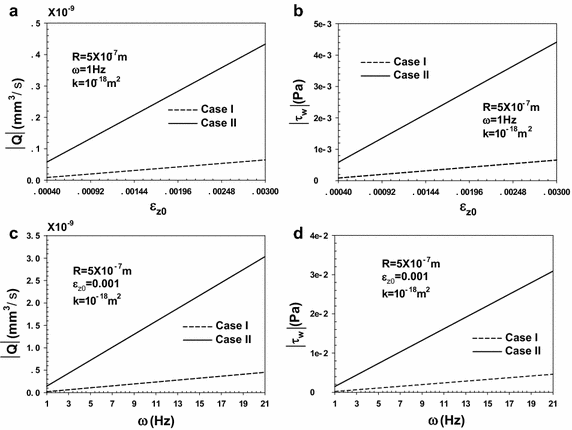Mathematically modeling fluid flow and fluid shear stress in the canaliculi of a loaded osteon
- PMID: 28155688
- PMCID: PMC5260136
- DOI: 10.1186/s12938-016-0267-x
Mathematically modeling fluid flow and fluid shear stress in the canaliculi of a loaded osteon
Abstract
Background: Mechanical load-induced intraosseous pressure gradients may result in some fluid stimuli effects, such as fluid flow and fluid shear stress (FSS), which may enable bone cells to detect external mechanical signals. Interstitial bone fluid flow is known to occur in lacunar-canalicular porosity (PLC).
Methods: In order to characterize lacunar-canalicular fluid flow behavior, a hierarchical osteon system is developed. The osteon is modeled as a poroelastic annular cylinder with two types of impermeable boundary cases considered on its outer wall: one is elastic restrained (Case I), whereas the other is displacement confined (Case II). Analytical solutions such as canalicular fluid velocity, pressure, fluid flow rate (FFR), and shear stress are obtained.
Results: Results show that the amplitudes of FFR and FSS are proportional to strain amplitude and frequency. However, the key loading factor governing canalicular fluid flow behavior is the strain rate. The larger canalicular radius is, the larger amplitudes of FFR and FSS generalized, especially, the FSS amplitude is proportional to canalicular radius. In addition, both FFR and FSS amplitudes produced in case II are larger than those of case I.
Conclusion: Strain rate can be acted as a representative loading parameter governing the canalicular fluid flow behavior under a physiological state. This model can facilitate better understanding the load induced the fluid permeation in the PLC. The approach can also be used to analyze the structure of the proteoglycan matrix in the fluid space surrounding the osteocytic process in the canaliculus.
Keywords: Canaliculi; Fluid flow rates (FFR); Fluid shear stress (FSS); Osteon; Poroelasticity.
Figures








References
-
- Wu XG, Chen WY, Gao ZP, et al. The effects of haversian fluid pressure and harmonic axial loading on the poroelastic behaviors of a single osteon. Sci China Phys Mech Astron. 2012;55(9):1646–1656. doi: 10.1007/s11433-012-4829-z. - DOI
-
- Burger EH, Klein-Nulend J. Mechanotransduction in bone: role of the lacuno-canalicular network. FASEB J. 1999;13(9001):101–112. - PubMed
MeSH terms
LinkOut - more resources
Full Text Sources
Other Literature Sources

